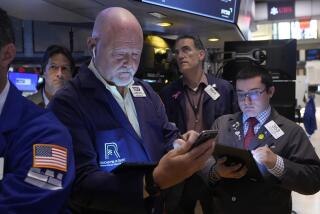Currency Chaos Sends Gold Over $400 Mark : Markets: Disarray in Europe’s exchange rate system also fuels interest in silver; profit takers slice 27.95 off Dow.
Gold surged past the $400 mark on Friday as investors ran for cover amid extraordinary turmoil in European currency markets and growing fears that Europe’s monetary union is on the verge of collapse.
Meanwhile, U.S. stocks were hit by mild profit taking, slicing 27.95 points off the Dow industrials, to 3,539.47.
But French, Belgian and British shares surged on expectations that the currency uproar will eventually result in lower European interest rates.
A massive wave of speculation against the French franc put pressure on the French government to devalue its currency. A devaluation of the franc, following last September’s departure of the Italian lira and the British pound from Europe’s Exchange Rate Mechanism, or ERM, would probably derail any movement toward a unified currency, analysts said.
The failure of the effort to unify European currencies would further delay fulfillment of Europe’s long-standing dream of political unity.
Six European central banks, including the Bank of France and the Bundesbank in Germany, bought large amounts of francs in an effort to keep the currency above the minimum value allowed under the ERM.
The day’s hottest action was in the gold market, where August futures on the New York Commodity Exchange jumped $9.20 to $407 an ounce--the first close above $400 since January, 1991, in the midst of Operation Desert Storm.
The gold rally that began last spring on inflation jitters has been refueled by the strains on Europe’s 14-year-old exchange rate mechanism, the system that is supposed to keep a lid on currency volatility.
With the ERM now in disarray and perhaps doomed by Germany’s insistence on maintaining high interest rates--at the expense of its increasingly angry neighbors--European currency values have fluctuated wildly this week.
Many traders, unable to determine how European currencies will sort out if the ERM breaks apart, have fled key currencies and bought gold instead.
“The currency dislocations in Europe have created instability that directly led to safe-haven buying in gold,” said Refco Inc. analyst James Steel.
Silver futures also shot up Friday, following gold. August silver contracts rocketed 18.8 cents to $5.39 an ounce on New York’s Comex, the highest price since February, 1990.
So far this year, gold has risen $74.20 an ounce, or 22%. Many analysts believe the rally will feed on itself from here.
Gold wasn’t alone in benefiting from the currency debacle: Key European stock markets rose sharply, essentially betting on a breakup of the ERM.
In Paris, the CAC-40 stock index zoomed 49.88 points, or 2.5%, to 2,085.88, on optimism that the end of the ERM would allow France to slash its high short-term interest rates, even if that means a devaluation of the French franc.
Likewise, Belgian stocks also gained. In Brussels, the BEL-20 index jumped 26.35 points, or 2%, to 1,326.36. And in London, the FTSE-100 index added 8.9 points to 2,926.5, on top of Thursday’s hefty 33.4-point rise.
The prospect of falling interest rates in most of Europe is tantalizing to many international investors, who remember that the U.S. stock market performed well in 1991 and 1992 largely because of sliding rates. In theory, lower rates would help spark the European economy.
German stocks, however, didn’t rally with their counterparts on Friday. In Frankfurt, the DAX index dropped 30.47 points, or 1.7%, to 1,803.23. Most traders believe Germany will maintain its high interest rates--to fight inflation--even if the rest of Europe breaks away and cuts rates, sacrificing their currencies’ values.
In the United States, stocks were mostly lower, but analysts said the decline was only peripherally related to problems in Europe.
The Dow industrials’ 27.95-point decline was driven by profit-taking in a number of blue chips that had run up recently, including AlliedSignal, off 1 1/4 to 70 1/8; AT&T;, down 7/8 to 63 3/8; Caterpillar, off 1/2 to 76 7/8; and Exxon, which lost 1/2 to 65 5/8.
Also, 3M Co. sank 3 3/4 to 105 after reporting disappointing second-quarter earnings. The firm, in part, blamed the strong dollar, which reduces earnings contributions from overseas subsidiaries.
Some traders suggested that 3M’s dollar troubles may have spooked investors. Because the dollar has been rising as most European currencies sink in the ERM crisis, Wall Street worries that U.S. multinational companies’ earnings could be clipped again in coming months if the expected decline in European interest rates bolsters the dollar further.
Among the highlights:
* Transportation stocks bucked the general downward trend, rallying briskly with the help of United Airlines parent UAL, which surged 5 to 144. The company on Thursday reported quarterly earnings above expectations.
Other transports rising included Conrail, up 1 5/8 to 56 3/8; Norfolk Southern, up 1 1/2 to 64 5/8, and truck lessor XTRA, up 1 3/8 to 44 7/8.
* Technology stocks were mixed. Microsoft plunged 5 to 74 after analysts trimmed earnings estimates.
Also falling were Lotus, down 2 7/8 to 36; Oracle, off 1 1/2 to 50 3/8; and PowerSoft, down 3 to 31 1/4.
But Computer Sciences gained 1 7/8 to 84 3/8, Motorola jumped 1 3/8 to 90 5/8 and Hewlett-Packard was up 1 to 72.
In other markets:
* Interest rates were mostly flat. The yield on the 30-year Treasury bond ended at 6.56%, down from 6.57% on Thursday.
* The dollar was mixed after gaining sharply against European currencies on Thursday. The dollar closed at 1.741 German marks in New York, flat with Thursday. But against the Japanese yen the dollar fell to 104.80 from 106.52.
* In Tokyo, the Nikkei stock index eased 76.71 points to 20,380.14, awaiting more news on the new government formed Thursday.
The Washington Post contributed to this story.
Market Roundup, D6
More to Read
Sign up for Essential California
The most important California stories and recommendations in your inbox every morning.
You may occasionally receive promotional content from the Los Angeles Times.










